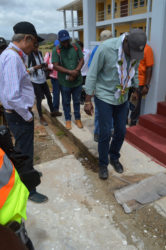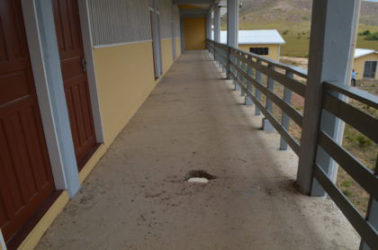A team of ministers yesterday visited the unoccupied Kato Secondary School, in Region Eight, to examine the state of the building and the scope of needed rehabilitation works.
According to a Govern-ment Information Agency (GINA) report, the team comprised Minister of Public Infrastructure David Patterson, Minister of Indigenous Peoples’ Affairs Sydney Allicock, Minister of Education Dr. Rupert Roopnaraine and Minister of Social Cohesion Dr. George Norton along with their technical staff.

The team was accompanied by Regional Execu-tive Officer for the Region Raphael Downes as well as a Guyana Association of Professional Engineers (GAPE) representative.
The Kato Secondary School was built under the former PPP/C administration to facilitate students in the region who travel long distances to access secondary level education. However, due to the substandard work done by the contractor, it has not been occupied.
The school was built at a cost of $728.1 million and consulting firm Rodrigues Architects Limited (RAL), which conducted an audit of the works last year, has said that at least $144 million would be required to fix the defects.
Contractor Kares Engineering has defended its performance, while saying the government never requested corrections as provided for in the contract.
The GINA report said that from the tour yesterday it was very evident that substandard works were done. “This was visible by the cracking walls, floors which were either being eaten by termites or with large holes, poor toilet facilities and faulty electrical wiring….,” it said.
Minister Patterson was reported as saying that the building is in a much worse state since the last audit of the works last year.

He said that an independent consultant from GAPE will detail the works needed to be done, in addition to what is identified in the two audit reports.
“We will be seeking from them [GAPE] their recommendations. If the consultancy has to be done by a structural engineer, then it is a must… I do think we need a mechanical engineer, and an electrical engineer. As you look around there is no electricity, and if you look around the pipe works are all exposed,” the minister noted. “We are trying to find a solution, because it is unfair to the community if we do not try to find a solution,” he added.
Minister Roopnaraine was quoted as saying that after looking at the building, there is not much that was “redemptive.” “There is a lot of work to do. There is a lot of shabby work that has been done, and I think we have to go into major repairs and reconstruction,” he told GINA.
Meanwhile, GAPE’s representative, Jean Ramkellawan, said that after touring the school, it was clear that a lot of substandard work had been done. Based on Ramkellawan’s assessment, “very poor supervision” was one of the main causes for the building’s state.
The GINA release said it is hoped that works on the building would be started and completed as quickly as possible.
In the audit report, RAL stated that in addition to the fact the works were poorly done, the engineering design information was incomplete and unreliable for construction.
In addition, it pointed out that the bills of quantities were scant and in many instances imprecise and not reflective of the remote location of the project.
Based on the general poor quality of concrete work, reduced steel reinforcement and numerous substitutions of materials, RAL concluded in the report that the construction was poorly done to maximize profit.




